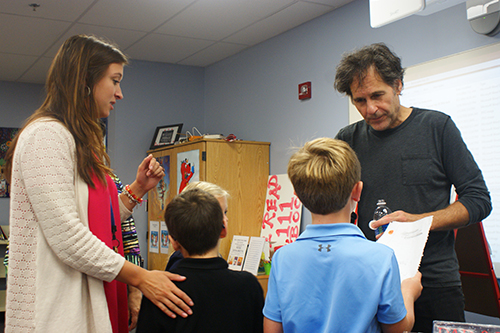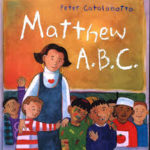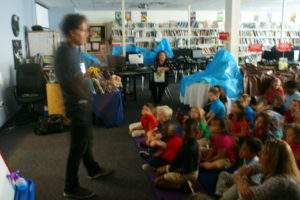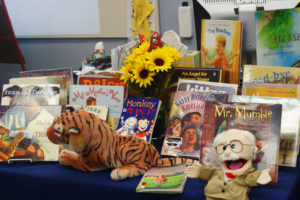Author Catalanotto Delights WCA Lower School Students in Visit

- October 11, 2017
- 2017-2018, Academics, Arts, Events, Lower School News
- art, author, catalanotto, children's books, Dylans Day off, Ivan the Terrier, Library, lower school, Matthew ABC, peter, Peter Catalanotto
The author selected the owner of a raised hand in the crowd. The student asked how he comes up with ideas for the artwork in his books. He answered the question and then added, “Don’t stop with your first idea, because your first idea, really, probably stinks. I know, I’ve had thousands of ideas, and for the most part, in the beginning, they stunk.” He continued to explain that great ideas develop over time, and start from humble beginnings.
Peter Catalanotto visited the Lower School students and shared his insights on writing, the creative process, and art in a way that was able to reach down to even the youngest 3 and 4-year-olds in the preschool programs. Catalanotto, an author of more than 45 children’s books over a career that has spanned 30 years, started as a book illustrator and his art has been one of the defining features of his books. But just as diverse as his book subjects are, from his Monkey and Robot classic, to Dylan’s Day Off and Matthew A.B.C., so is the art contained in it, as Catalanotto customizes the art in each book to the story he is looking to tell.
One of the major themes Catalanotto delved into in his talk was the use of personal experience in storytelling. The best novels he has written, per his account, have come from personal  experiences, particularly in his youth. Matthew A.B.C., for example, is a story of a class of 25 children who are all named Matthew, and are identified primarily by their last initial (the twist being that each also curiously has a defining characteristic which starts with their last name initial). The story was inspired by his own childhood classroom experience when he was ‘Peter C.’ due to the fact that there was another Peter in his classroom. How do you take a story of a boy who shares the name of another boy in his class, and transform it into the hilarious collection of Matthew’s in Matthew A.B.C.? Two words: ‘What if?’. Catalanotto explained that he took his own personal story and added the question, ‘What if ALL the students in my class back then were named Peter?’. And so Matthew A.B.C. was born. He utilizes the question ‘What if?’ routinely to develop ideas that eventually become his children’s stories.
experiences, particularly in his youth. Matthew A.B.C., for example, is a story of a class of 25 children who are all named Matthew, and are identified primarily by their last initial (the twist being that each also curiously has a defining characteristic which starts with their last name initial). The story was inspired by his own childhood classroom experience when he was ‘Peter C.’ due to the fact that there was another Peter in his classroom. How do you take a story of a boy who shares the name of another boy in his class, and transform it into the hilarious collection of Matthew’s in Matthew A.B.C.? Two words: ‘What if?’. Catalanotto explained that he took his own personal story and added the question, ‘What if ALL the students in my class back then were named Peter?’. And so Matthew A.B.C. was born. He utilizes the question ‘What if?’ routinely to develop ideas that eventually become his children’s stories.
Catalanotto also treated the children to an amazing look into how he personally creates faces in his book artwork, which drew universal ‘oohs’ and ‘aah’s from the assembled students. The facial drawings were tied primarily to his book Question Boy Meets Little Miss Know-it-All. He emphasized acknowledging light and the role it plays in creating shadows as the artistic detail that takes the ordinary facial drawing to the extraordinary one. But even more importantly was the concept of drafting, that is, to make initial drawings without concern for perfection, but rather to get all the ideas and concepts out on the canvas without ever picking up an eraser, and then recreating the work as a final piece two, three, or more revisions afterward.
Williamsburg Christian Academy thanks Peter Catalanotto for visiting our school, and giving such a compelling and fun presentation to our Lower School Students and Faculty alike, both of whom were fascinated and intrigued by his knowledge, process and advice shared.
Author Catalanotto Delights WCA Lower School Students in Visit

- October 11, 2017
- 2017-2018, Academics, Arts, Events, Lower School News
- art, author, catalanotto, children's books, Dylans Day off, Ivan the Terrier, Library, lower school, Matthew ABC, peter, Peter Catalanotto
The author selected the owner of a raised hand in the crowd. The student asked how he comes up with ideas for the artwork in his books. He answered the question and then added, “Don’t stop with your first idea, because your first idea, really, probably stinks. I know, I’ve had thousands of ideas, and for the most part, in the beginning, they stunk.” He continued to explain that great ideas develop over time, and start from humble beginnings.
Peter Catalanotto visited the Lower School students and shared his insights on writing, the creative process, and art in a way that was able to reach down to even the youngest 3 and 4-year-olds in the preschool programs. Catalanotto, an author of more than 45 children’s books over a career that has spanned 30 years, started as a book illustrator and his art has been one of the defining features of his books. But just as diverse as his book subjects are, from his Monkey and Robot classic, to Dylan’s Day Off and Matthew A.B.C., so is the art contained in it, as Catalanotto customizes the art in each book to the story he is looking to tell.
One of the major themes Catalanotto delved into in his talk was the use of personal experience in storytelling. The best novels he has written, per his account, have come from personal  experiences, particularly in his youth. Matthew A.B.C., for example, is a story of a class of 25 children who are all named Matthew, and are identified primarily by their last initial (the twist being that each also curiously has a defining characteristic which starts with their last name initial). The story was inspired by his own childhood classroom experience when he was ‘Peter C.’ due to the fact that there was another Peter in his classroom. How do you take a story of a boy who shares the name of another boy in his class, and transform it into the hilarious collection of Matthew’s in Matthew A.B.C.? Two words: ‘What if?’. Catalanotto explained that he took his own personal story and added the question, ‘What if ALL the students in my class back then were named Peter?’. And so Matthew A.B.C. was born. He utilizes the question ‘What if?’ routinely to develop ideas that eventually become his children’s stories.
experiences, particularly in his youth. Matthew A.B.C., for example, is a story of a class of 25 children who are all named Matthew, and are identified primarily by their last initial (the twist being that each also curiously has a defining characteristic which starts with their last name initial). The story was inspired by his own childhood classroom experience when he was ‘Peter C.’ due to the fact that there was another Peter in his classroom. How do you take a story of a boy who shares the name of another boy in his class, and transform it into the hilarious collection of Matthew’s in Matthew A.B.C.? Two words: ‘What if?’. Catalanotto explained that he took his own personal story and added the question, ‘What if ALL the students in my class back then were named Peter?’. And so Matthew A.B.C. was born. He utilizes the question ‘What if?’ routinely to develop ideas that eventually become his children’s stories.
Catalanotto also treated the children to an amazing look into how he personally creates faces in his book artwork, which drew universal ‘oohs’ and ‘aah’s from the assembled students. The facial drawings were tied primarily to his book Question Boy Meets Little Miss Know-it-All. He emphasized acknowledging light and the role it plays in creating shadows as the artistic detail that takes the ordinary facial drawing to the extraordinary one. But even more importantly was the concept of drafting, that is, to make initial drawings without concern for perfection, but rather to get all the ideas and concepts out on the canvas without ever picking up an eraser, and then recreating the work as a final piece two, three, or more revisions afterward.
Williamsburg Christian Academy thanks Peter Catalanotto for visiting our school, and giving such a compelling and fun presentation to our Lower School Students and Faculty alike, both of whom were fascinated and intrigued by his knowledge, process and advice shared.
More News:



